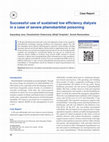Papers by Chandrashish Chakravarty
CHEST Critical Care, Nov 30, 2023

Indian Journal of Critical Care Case Report, Oct 26, 2023
fluid analysis, toxicology screening, and neuroimaging, were unremarkable. After 24 hours, there ... more fluid analysis, toxicology screening, and neuroimaging, were unremarkable. After 24 hours, there were no visible seizures, but her sensorium was not improving despite the sedation holiday. On further workup, she had respiratory alkalosis without any hyperlactatemia, anion gap, or metabolic acidosis, had a very high arterial ammonia level (356 µmol/L) and triphasic waveform in the electroencephalogram. Her phenytoin levels were adequate and she was normoglycemic. The liver appeared normal in ultrasonography and except for hydrocortisone used in the context of septic shock, no other culprit drug can be found. Urine culture revealed growth of Enterococcus faecalis and antimicrobials were adjusted accordingly. Sonologic measurement of optic nerve sheath diameter (ONSD) (Fig. ) at the bedside was suggestive of raised intracranial pressure (ONSD of >6 mm bilaterally) and effectively 1-4

stool sample for other viruses was also negative. In view of history and presenting symptoms, Sal... more stool sample for other viruses was also negative. In view of history and presenting symptoms, Salmonella infection was suspected and antibiotics were changed to ceftriaxone and azithromycin. Ertapenem was stopped. The Widal test on day 3 of hospital admission was found to be negative. On the 4th day of hospital admission, the patient continued spiking high-grade temperature, almost never touching baseline, and also developed a macular rash on the extensor surface of her forearms. H1N1 nasal swab, Weil-Felix, malarial parasites, and antinuclear antibody were sent and found to be negative. About two sets of blood cultures, however, were positive for A. hydrophila sensitive to ciprofloxacin (pansensitive), which was added to her treatment. On the 6th day of hospital admission, she developed severe arthralgia and her rash spread to her abdomen and became confluent. Further investigations
Indian Journal of Critical Care Medicine, 2013
The present study assessed the prevalence of malnutrition in patients hospitalized in ICU as the ... more The present study assessed the prevalence of malnutrition in patients hospitalized in ICU as the first step in devising a comprehensive nutritional care program.

Indian Journal of Critical Care Case Report
stool sample for other viruses was also negative. In view of history and presenting symptoms, Sal... more stool sample for other viruses was also negative. In view of history and presenting symptoms, Salmonella infection was suspected and antibiotics were changed to ceftriaxone and azithromycin. Ertapenem was stopped. The Widal test on day 3 of hospital admission was found to be negative. On the 4th day of hospital admission, the patient continued spiking high-grade temperature, almost never touching baseline, and also developed a macular rash on the extensor surface of her forearms. H1N1 nasal swab, Weil-Felix, malarial parasites, and antinuclear antibody were sent and found to be negative. About two sets of blood cultures, however, were positive for A. hydrophila sensitive to ciprofloxacin (pansensitive), which was added to her treatment. On the 6th day of hospital admission, she developed severe arthralgia and her rash spread to her abdomen and became confluent. Further investigations

Indian Journal of Critical Care Case Report, Nov 4, 2022
Postoperatively, he was shifted to the ICU in profound shock with no urine output. Vasopressor dr... more Postoperatively, he was shifted to the ICU in profound shock with no urine output. Vasopressor drug requirement was maximum. Antibiotics were stepped up in view of mixed inflammatory infiltrates in holoprosencephaly though cultures were not available. His cardiac output was monitored with an advanced Edwards volume view and transpulmonary thermodilution. Pulmonary edema was avoided by monitoring extravascular lung water. Colloids were given cautiously during the shock period. Gradually, his creatinine decreased without dialysis. His shock resolved, and he was extubated on postoperative day 2. His cultures were sterile. He improved gradually and was discharged from the hospital after 14 days of the operation after vaccination with meningococcal, pneumococcal, and Haemophilus influenzae type b vaccines. Histopathology showed splenic tissue with maintained parenchymal architecture, focal areas of congestion, and hemorrhage noted with breach of a splenic capsule and mixed inflammatory infiltrate. Features were consistent with splenic rupture.
Mechanically ventilated patients should have a daily assessment relating to their ability to be w... more Mechanically ventilated patients should have a daily assessment relating to their ability to be weaned from ventilatory support. A spontaneous breathing trial helps to identify patients who may be successfully extubated and the available evidence would suggest this should be in the form of an intermittent T-piece or a minimal-level pressure support trial for 30 minutes. Noninvasive ventilation can have a role in reducing the duration of mechanical ventilation in chronic obstructive pulmonary disease (COPD) patients but should not be used to treat extubation failure.

Indian Journal of Critical Care Medicine, 2018
Mastocytosis, a rare clonal disorder of abnormal mast cell (MC) proliferation, occurs at reported... more Mastocytosis, a rare clonal disorder of abnormal mast cell (MC) proliferation, occurs at reported incidence of approximately 5-10 cases/10 6 people/year. We report a case of an indolent systemic mastocytosis (ISM) who experienced anaphylactic shock during anesthetic induction. Written consent was obtained from the patient's relatives. A 57-year-old female patient (height 5'2" and body weight 55 kg) without any known comorbidity and any known drug allergy was posted for elective thyroidectomy for a colloid goiter. Computed tomography of the neck region showed the huge thyroid swelling compressing the airways [Figure ]. She was induced with injection propofol 120 mg intravenously followed by direct laryngoscopy and endotracheal intubation with a bougie. After successful intubation confirmed by capnography and bilateral air entry, she was connected to anesthesia machine. She was hemodynamically stable at this point and adequately ventilated. For adequate skeletal muscle relaxation for surgery, injection atracurium 30 mg intravenously was administered slowly, approximately 2 min after she developed profound hypotension (50/32 mmHg) Systemic mastocytosis is a rare disease due to abnormal proliferation of mast cells (MCs). A case of indolent systemic mastocytosis is presented here. After anesthetic induction for elective thyroid swelling with propofol and atracurium followed by endotracheal intubation, a 57-year-old female patient developed acute hypotension, sinus tachycardia, red rashes, increased airway pressure along with difficult ventilation, and desaturation. She developed multiorgan failure subsequently. MC tryptase level was persistently high. Bone marrow study revealed mastocytosis. She required antihistaminic, steroid, and organ support. With treatment, organ functions recovered gradually. Atracurium precipitated anaphylactic shock causing severe morbidity in this patient.
Anaesthesia and Intensive Care, 2009
This case report describes the successful management of a patient with diabetic ketoacidosis, who... more This case report describes the successful management of a patient with diabetic ketoacidosis, who developed torsades de pointes leading to nine cardiac arrests secondary to intravenous fluconazole administration on a background of hypokalaemia and hypocalcaemia.
The Southeast Asian journal of tropical medicine and public health, 2016
Cladophialophora bantiana is a dematiceous fungus with neurotrophic propensity for which therapy ... more Cladophialophora bantiana is a dematiceous fungus with neurotrophic propensity for which therapy is not standardized and mortality is high. We report here a 49 year old non-diabetic renal transplant patient on triple immunosuppressant therapy who presented with a history of falls, weakness and headaches. A computed tomography scan of the brain revealed a 30 mm diameter abscess in the brain which was removed surgically and diagnosed on culture as C. bantiana. The patient was successfully treated medically post-operatively with chronic posaconazole. We review the literature regarding central nervous system infections due to C. bantiana.

Lung India : official organ of Indian Chest Society
Ventilator-associated tracheobronchitis (VAT) is an infective complication of mechanical ventilat... more Ventilator-associated tracheobronchitis (VAT) is an infective complication of mechanical ventilation and is a part of the spectrum of ventilator-associated respiratory infections. In the Intensive Care Units (ICUs), VAT is a relatively common problem but in comparison to ventilator-associated pneumonia (VAP), much less data are available on VAT and its management. Patients ventilated for more than 48 hours were screened daily for the development of VAT. Patients were followed up daily until they were extubated, died or discharged from the hospital. The patient demographics, underlying condition, causative organism and resistance patterns were observed. 13.2% of patients developed VAT. The majority patients who developed VAT had underlying neurological problems. The mean time to develop VAT from the time of mechanical ventilation was 7.3 days and from time of ICU admission was 10 days, respectively. Multidrug-resistant (MDR) Acinetobacter sp. and Pseudomonas aeruginosa were the most ...

Mycoses, 2017
SummaryProbiotics are increasingly used in critically ill patients without enough safety data. Th... more SummaryProbiotics are increasingly used in critically ill patients without enough safety data. The aim of the present study was to determine the association of probiotics with Saccharomyces cerevisiae fungaemia. Seven patients with S. cerevisiae fungaemia were reported at two hospitals in India between July 2014 and September 2015. Detailed clinical history of patients was recorded. Besides the seven patient isolates, three probiotics sachets used in those patients and five unrelated clinical isolates were used for association study by Fluorescent amplified fragment length polymorphism (FAFLP). Antifungal susceptibility testing was performed by broth microdilution technique of CLSI (M27‐A3) and interpreted according to CLSI (M27S4). Two patients were premature neonates and five were adults. They were admitted in intensive care unit and were on probiotics containing S. boulardii (except one adult patient). FAFLP analysis showed 96.4‐99.7% similarity between blood and corresponding pr...

JMM Case Reports, 2015
Introduction: Serratia marcescens is an opportunistic Gram-negative bacillus capable of causing s... more Introduction: Serratia marcescens is an opportunistic Gram-negative bacillus capable of causing serious nosocomial infection. Skin infections due to S. marcescens, although not frequently encountered, can have a variety of manifestations and may progress to become serious debilitating lesions if not diagnosed early and treated promptly. We report here a case of multiple skin lesions due to S. marcescens in an immunocompromised patient. Case presentation: A 60-year-old patient on adjuvant chemotherapy for breast carcinoma developed a high fever followed by multiple painful nodular and ulcerated lesions over all four limbs. Multidrug-resistant S. marcescens was isolated from the blood as well as from several skin lesions. Removal of the infective source (a chemoport in this case) and administration of tigecycline resulted in resolution of the infection. S. marcescens is a nosocomial pathogen capable of causing extensive cutaneous lesions. Multiple samples for culture from the lesions are recommended to identify the aetiological agent and institute appropriate antibiotics. The emergence of multidrug-resistant strains has compromised treatment options for this bacterium, which is intrinsically resistant to several groups of antibiotics.

Indian Journal of Critical Care Medicine, 2014
A 30-year-old female presented with coma and subsequent cardiac arrest caused by phenobarbital ov... more A 30-year-old female presented with coma and subsequent cardiac arrest caused by phenobarbital overdosage, requiring ventilatory and vasopressor support. She had also developed severe hypoxia following gastric aspiration. Initial therapy, including activated charcoal and forced alkaline diuresis, failed to signifi cantly lower her drug levels and there was minimal neurological improvement. As she was hemodynamically unstable, and unsuitable for conventional dialysis, she was put on sustained low effi ciency dialysis (SLED) to facilitate drug removal. SLED resulted in marked reduction in plasma level of phenobarbital, which eventually led to early extubation, improved cognition and aided full recovery. Thus, we concluded that SLED can be an effective alternative in cases of severe phenobarbital poisoning, where conventional hemodialysis or hemoperfusion cannot be initiated, to hasten drug elimination and facilitate early recovery.
Apollo Medicine, 2014
Elizabethkingia meningoseptica is emerging as a cause of hospital acquired infection particularly... more Elizabethkingia meningoseptica is emerging as a cause of hospital acquired infection particularly in immunocompromised adults. The treatment of this bacterium is difficult since it is intrinsically resistant to a number of antibiotics. Here we report two cases of septicemia in patients who were critically ill and were successfully treated with appropriate antibiotics. Cotrimoxazole, quinolones, and rifampicin seem to be drugs effective against E. meningoseptica. Antibiotic susceptibility results are ineffective in guiding treatment. The bacterium particularly colonizes water pipelines and tap faucets and occurrence of infection by this bacterium should direct attention towards eradicating the source of this bacterium.

Acta Anaesthesiologica Taiwanica, 2011
Supraglottic airways (SGA) through which blind endotracheal intubation is made possible is an are... more Supraglottic airways (SGA) through which blind endotracheal intubation is made possible is an area of considerable interest. Our study aimed at comparing the Cobra Perilaryngeal Airway (CPLA) with the Intubating Laryngeal Mask Airway (ILMA) with regard to the performance of the former as a conduit for facilitating blind endotracheal intubation. American Society of Anesthesiologists (ASA) I-II patients consenting to the study, with no predictors of difficult airway, scheduled for elective surgery were randomized into two groups of 30 each. Anesthesia was induced with fentanyl, propofol and vecuronium. CPLA was inserted in Group I and ILMA in Group II. Fibreoptic scoring of the laryngeal view was done through the SGA. Blind intubation through either CPLA or ILMA was then carried out with cuffed polyvinyl chloride (PVC) tube in Group I and ILMA-tracheal tube in Group II. Demographic and surgical data were comparable between the two groups. The success rate of intubation (87% through CPLA and 90% through ILMA) (p value 1), number of attempts made and the fibreoptic scores (p value 0.12) were comparable between the two groups. Insertion time was significantly longer in Group I as compared with Group II (9 s vs. 4 s; p value 0.004). Trauma and sore throat were more common in Group I (p value -0.1, 0.19 respectively). Hemodynamic monitoring showed more tachycardia during CPLA insertion as compared with ILMA (p value 0.006). We conclude that CPLA can be used as an effective conduit for blind endotracheal intubation with cuffed PVC tube and has comparable efficacy in tracheal intubation as that with ILMA.
Pediatric Anesthesia, 2009
... Additional Information. How to Cite. Surender, RA, Chandrashish, C., Handa, KK and Rajeshwari... more ... Additional Information. How to Cite. Surender, RA, Chandrashish, C., Handa, KK and Rajeshwari,S. (2009), Operating laryngoscope in a failed intubation scenario. Pediatric Anesthesia, 19: 274275. doi: 10.1111/j.1460-9592.2008.02820.x. Author Information. 1 ...
Journal of Clinical Anesthesia, 2010
Lowe's syndrome is a rare inherited metabolic disorder characterized by mental retardation, kidne... more Lowe's syndrome is a rare inherited metabolic disorder characterized by mental retardation, kidney malfunction, and abnormalities of the eyes and bones. A 4 month-old child with Lowe's and Fanconi's syndrome, undergoing bilateral congenital cataract surgery, is presented. Preoperative electrolyte imbalance was corrected by potassium, calcium, magnesium, phosphate, and bicarbonate supplementation. Anesthesia was administered uneventfully using appropriate anesthetic agents and monitoring. Adequate preoperative evaluation and optimization, along with selection of anesthetic agents and fluid and electrolyte management with appropriate perioperative monitoring, is key to a successful outcome.






Uploads
Papers by Chandrashish Chakravarty